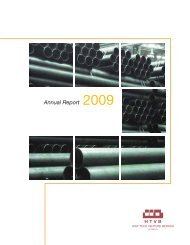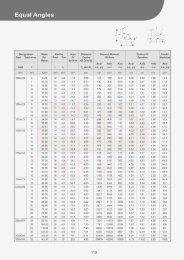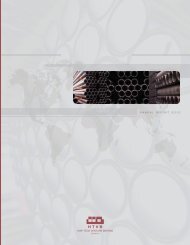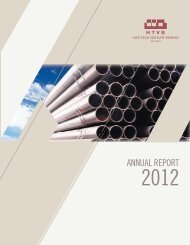2004 - Hiap Teck Venture Berhad
2004 - Hiap Teck Venture Berhad
2004 - Hiap Teck Venture Berhad
Create successful ePaper yourself
Turn your PDF publications into a flip-book with our unique Google optimized e-Paper software.
2. SIGNIFICANT ACCOUNTING POLICIES (CONT’D)<br />
(h)<br />
Provisions for Liabilities<br />
Provisions for liabilities are recognised when the Group has a present obligation as a result of a past event<br />
and it is probable that an outflow of resources embodying economic benefits will be required to settle the<br />
obligation, and a reliable estimate of the amount can be made. Provisions are reviewed at each balance<br />
sheet date and adjusted to reflect the current best estimate. Where the effect of the time value of money is<br />
material, the amount of a provision is the present value of the expenditure expected to be required to settle<br />
the obligation.<br />
(i)<br />
Income Tax<br />
Income tax on the profit or loss for the year comprises current and deferred tax. Current tax is the expected<br />
amount of income taxes payable in respect of the taxable profit for the year and is measured using the tax<br />
rates that have been enacted at the balance sheet date.<br />
Deferred tax is provided for, using the liability method, on temporary differences at the balance sheet date<br />
between the tax bases of assets and liabilities and their carrying amounts in the financial statements. In<br />
principle, deferred tax liabilities are recognised for all taxable temporary differences and deferred tax assets<br />
are recognised for all deductible temporary differences, unused tax losses and unused tax credits to the<br />
extent that it is probable that taxable profit will be available against which the deductible temporary<br />
differences, unused tax losses and unused tax credits can be utilised. Deferred tax is not recognised if the<br />
temporary difference arises from goodwill or negative goodwill or from the initial recognition of an asset or<br />
liability in a transaction which is not a business combination and at the time of the transaction, affects neither<br />
accounting profit nor taxable profit.<br />
Deferred tax is measured at the tax rates that are expected to apply in the period when the asset is realised<br />
or the liability is settled, based on tax rates that have been enacted or substantively enacted at the balance<br />
sheet date. Deferred tax is recognised in the income statement, except when it arises from a transaction<br />
which is recognised directly in equity in which case the deferred tax is also recognised directly in equity, or<br />
when it arises from a business combination that is an acquisition, in which case the deferred tax is included<br />
in the resulting goodwill or negative goodwill.<br />
(j)<br />
Leases<br />
A lease is recognised as a finance lease if it transfers substantially to the Group all the risks and rewards<br />
incident to ownership. All other leases are classified as operating leases.<br />
(i)<br />
Finance leases<br />
Assets acquired by way of hire purchase or finance leases are stated at an amount equal to the lower<br />
of their fair values and the present value of the minimum lease payments at the inception of the leases,<br />
less accumulated depreciation and impairment losses. The corresponding liability is included in the<br />
balance sheet as borrowings. In calculating the present value of the minimum lease payments, the<br />
discount factor used is the interest rate implicit in the lease, when it is practicable to determine;<br />
otherwise, the Company’s incremental borrowing rate is used.<br />
Lease payments are apportioned between the finance costs and the reduction of the outstanding<br />
liability. Finance costs, which represent the difference between the total leasing commitments and the<br />
fair value of the assets acquired, are recognised as an expense in the income statement over the term<br />
of the relevant lease so as to produce a constant periodic rate of charge on the remaining balance of<br />
the obligations for each accounting period.<br />
The depreciation policy for leased assets is in accordance with that for depreciable property, plant and<br />
equipment as described in Note 2(e).<br />
(ii)<br />
Operating leases<br />
Operating lease payments are recognised as an expense in the income statement on a straight-line<br />
basis over the term of the relevant lease.<br />
32 HIAP TECK VENTURE BERHAD




